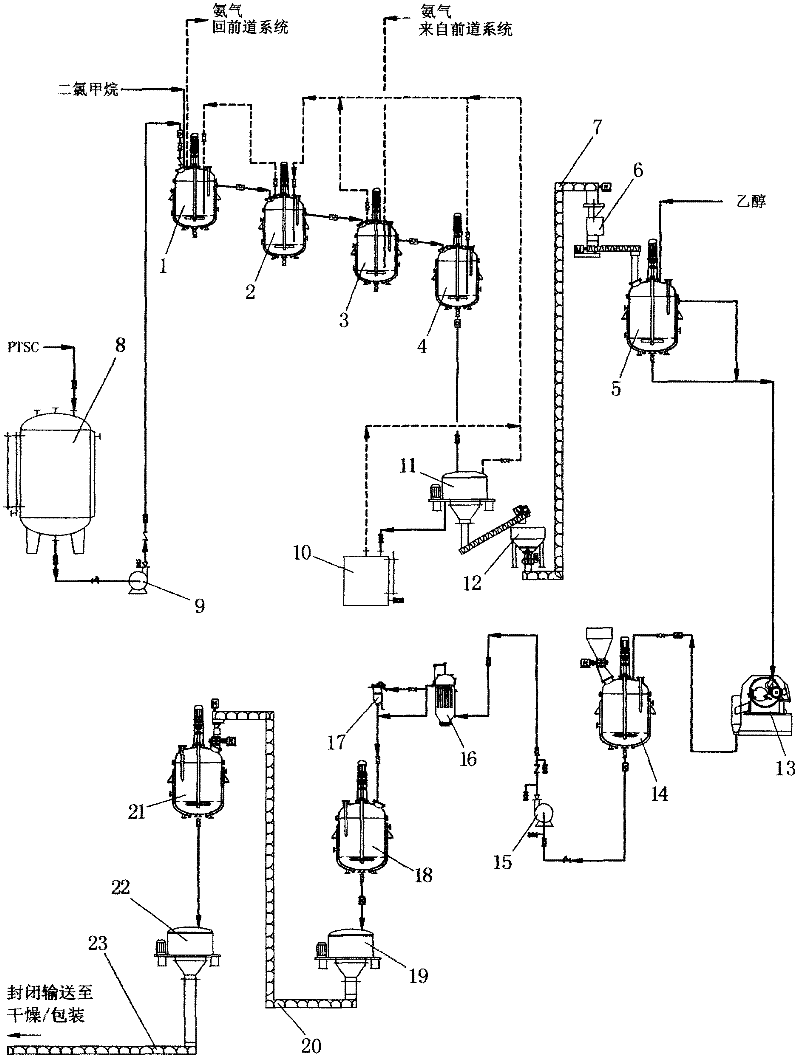Industrial production method for toluene sulfonamide
A technology of p-toluenesulfonamide and p-toluenesulfonyl chloride, which is applied in the field of industrial production of p-toluenesulfonamide, can solve the problems of high labor intensity, large amount of ammonia nitrogen, low yield, etc., to reduce labor intensity, reduce COD emissions, reduce Effects of Environmental Pollution
- Summary
- Abstract
- Description
- Claims
- Application Information
AI Technical Summary
Problems solved by technology
Method used
Image
Examples
Embodiment 1
[0042] The dichloromethane solution of p-toluenesulfonyl chloride is sent from the acid chloride workshop to the intermediate storage tank. Then the dichloromethane solution of p-toluenesulfonyl chloride is injected into the first-level amination still with the speed of 300kg / h by delivery pump, and puts into the first-level amination still with the dichloromethane from head tank at the speed of 450kg / h simultaneously . Through the side outlet of the primary amination kettle, it enters the secondary amination kettle in the form of overflow, and then enters the third-level amination kettle in the form of overflow through the side outlet of the second-level amination kettle, and then enters the fourth-level amination kettle in the same way. grade amination kettle. Then it enters the centrifuge through the lower outlet of the fourth-stage amination kettle. Reactor temperature control is 20~35 ℃.
[0043] Ammonia gas enters from the three-stage amination kettle with a flow rate...
Embodiment 2
[0050] Process is identical with embodiment 1, and each process parameter is:
[0051] The dichloromethane solution of p-toluenesulfonyl chloride is squeezed into the primary amination still with the speed of 560kg / h,
[0052] Dichloromethane is put into the primary amination kettle from the head tank at a speed of 840kg / h,
[0053] The temperature of the amination reaction is controlled at 20-35°C,
[0054] The flow rate of the ammonia entering the three-stage amination kettle is 51kg / h,
[0055] The temperature of the dissolution tank is controlled at 70-80°C,
[0056] The temperature of the decolorization kettle is controlled at 70-80°C,
[0057] The temperature of the crystallization tank is controlled at 5-15°C,
[0058] The washing temperature of the washing tank is 25-40°C.
[0059] After the system operated for 195 hours, 48.882t of p-toluenesulfonamide was obtained, and the output rate was 251kg / h.
Embodiment 3
[0061] Process is identical with embodiment 1, and each process parameter is:
[0062] The dichloromethane solution of p-toluenesulfonyl chloride is injected into the primary amination kettle at a speed of 1000kg / h,
[0063] Dichloromethane is put into the primary amination kettle from the head tank at a speed of 1500kg / h,
[0064] The temperature of the amination reaction is controlled at 20-35°C,
[0065] The flow rate of the ammonia entering the three-stage amination kettle is 90kg / h,
[0066] The temperature of the dissolution tank is controlled at 70-80°C,
[0067] The temperature of the decolorization kettle is controlled at 70-80°C,
[0068] The temperature of the crystallization tank is controlled at 5-15°C,
[0069] The washing temperature of the washing tank is 25-40°C.
[0070] After running the system for 288 hours, 128.921t of p-toluenesulfonamide was obtained, and the output rate was 447kg / h.
PUM
 Login to View More
Login to View More Abstract
Description
Claims
Application Information
 Login to View More
Login to View More - R&D
- Intellectual Property
- Life Sciences
- Materials
- Tech Scout
- Unparalleled Data Quality
- Higher Quality Content
- 60% Fewer Hallucinations
Browse by: Latest US Patents, China's latest patents, Technical Efficacy Thesaurus, Application Domain, Technology Topic, Popular Technical Reports.
© 2025 PatSnap. All rights reserved.Legal|Privacy policy|Modern Slavery Act Transparency Statement|Sitemap|About US| Contact US: help@patsnap.com



